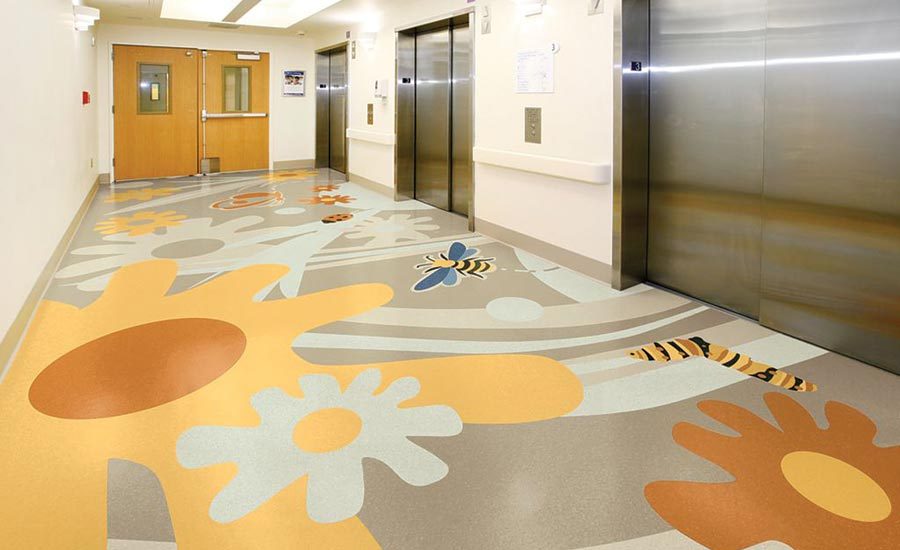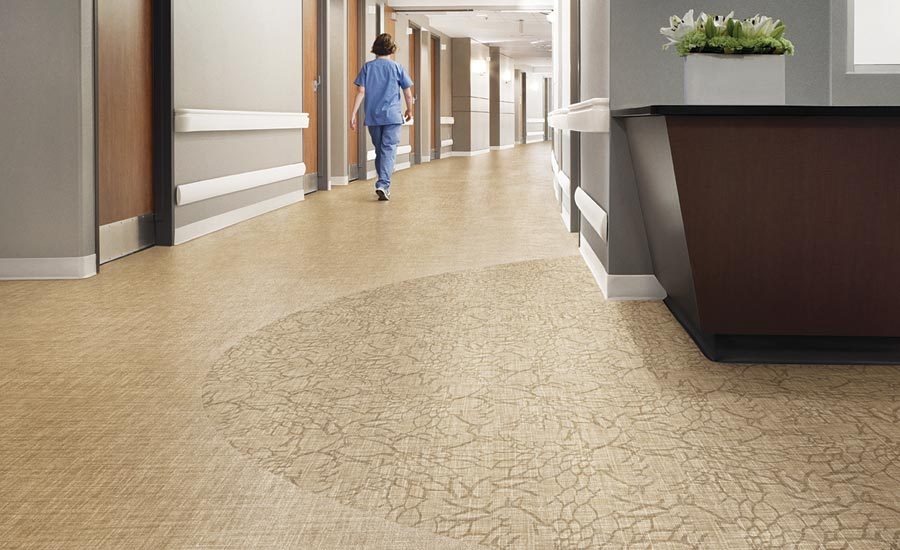Choosing Flooring for Healthcare Environments

Mr. David’s Flooring and the Proteus Group designed and installed flooring inspired by Chicago’s four seasons at Rush University Medical Center Pediatric Intensive Care Unit to lift the spirits of children undergoing treatment.

Shaw Contract’s product portfolio allows clients to mix and match products to meet design and function needs.

Luxury vinyl tile like Metroflor’s Aspecta Five is being used more commonly in healthcare because of its homelike design capabilities.


Ecore’s flooring for healthcare applications is durable, easy to maintain and created to support patient mobility.

Infection control in healthcare facilities is a top priority, and with the help of Mannington’s Seam+Advantage, seamless transitions can be created to keep bacteria and other health hazards away.






From hospitals to clinics, doctor’s offices and medical centers, flooring in the healthcare arena is playing an important role in wellbeing, healing and overall patient experience.
Healthcare Flooring Must-Haves
While each healthcare facility has its own specific needs and requirements, when it comes to flooring in healthcare applications, a few criteria must be met across the board.
“There are certain givens that we traditionally associate with performance,” said Mark Huxta, director of sales–healthcare for Ecore. “In particular, the product must be durable, easy to maintain and support patient mobility. With regard to mobility, this includes ambulatory and roller mobility related to heavy roller loads. These givens represent the minimum performance requirement for a flooring product.”
Be it on foot or with the assistance of a wheelchair or walking aid, supporting patient mobility—and even the occasional fall—in all healthcare environments is a top priority. Mobility for a variety of patients as well as staff must be taken into careful consideration when selecting flooring for these facilities.
“Most recently, problems such as ease of movement across various floor types, along with enhanced noise control, are additional concerns that the healthcare designer needs to take into consideration,” said Paul Eanes, vice president, sales, Metroflor Corporation.
According to Kathy Griffel, Mannington Mills’ director of healthcare/education sales, factoring in more than just slips and falls is important when it comes to selecting floors that are safe to walk on for healthcare facilities. “This is more than just slip and fall, but also security and comfort underfoot. These all add up for employees of a healthcare facility, as well as patients.”
Griffel also noted that a floor’s gloss level is important. “It is relevant to eye fatigue of employees as well as elderly patients,” she said. “The floor has to look clean, but cannot glare or give people a feeling that they are going to slip.”
“The product must be durable, easy to maintain and support patient mobility.”
In a healing environment, noise control plays a major role in a patient’s healing, progress and comfort, and with the help of select flooring types, noise levels can be kept at bay.
“Balanced choice flooring selections keep the space safe, quiet and comfortable,” said Chris Stulpin, senior vice president of design for Tarkett North America. “For example, our Powerbond hybrid sheet flooring offers a noise reduction coefficient that allows for a quieter environment, improving patient care and staff morale.”
In healthcare, maintaining a clean—and in some cases sterile—environment is critical, and floors in these spaces must be able to stand up to the required maintenance policies and guidelines.
“Surfaces must be sterile and promote healing, a floor’s maintenance products and procedures are critical considerations,” said Huxta. “The industry has responded with a number of effective “no wax” floor finishes that eliminate the cost and disruption associated with the strip, wax and buff process. The disposal of caustic stripping chemicals in this process has also been eliminated, resulting in a reduced environmental impact.”
Many cleaning and sterilization measures are taken throughout healthcare facilities to address infection control, and according to Griffel, when it comes to flooring, infection control is best addressed when product installations are seamless.
“Mannington’s Seam+Advantage enables sheet, luxury vinyl tile (LVT) and even carpet products to be chemically welded to each other, creating truly seamless transitions without transition strips,” said Griffel. “Bacteria can hide behind transition strips, which are also slip and fall hazards and impede roller mobility.”
For procedure rooms, operating rooms and laboratories, Armstrong Flooring, for example, offers homogeneous sheet flooring that can be heat-welded and flash-coved for spaces demanding superior infection control. According to the company, procedure and operating rooms need an aseptic, sterile environment, heat-welded seams with flash coving, resistance to stains from chemical reagents and bodily fluids, resistance to rolling loads, long life and easy maintenance.
Design and the Patient Experience
For flooring that is easy to clean as well as easy on the eyes, Lindsey Nisbet of EarthWerks says LVT is the answer. “[LVT] (and planks) are ideal for healthcare due to their hygienic attributes—they are easy to clean, low maintenance and waterproof. EarthWerks LVT is also durable and performs great in healthcare settings. With the versatility of LVT, the specifications can be made to accommodate the lightest traffic to the heaviest settings.” Additionally, Nisbet noted that design capabilities with LVT are endless, allowing for calming residential feels to fun and eye-popping patterns.
Even with its cleanability and design capabilities, LVT is not the only answer to all of healthcare’s flooring needs. In healthcare environments, the idea of ‘one size fits all’ does not hold true when it comes to flooring, and designers are still finding use for carpet and resilient products.
“There are different environments within healthcare that have their own unique requirements, or properties that are required for the floor covering,” said Chip Braulick, CBC Flooring’s director of flooring.
Designers are mixing styles and products that meet healthcare facility’s needs, while being visually appealing for patients.
Click here for more about flooring for the healthcare segment
“Healthcare clients prefer a cohesive design that is not visually sterile. Increasingly, healthcare flooring is designed with visuals to provide flexibility within a space,” said Reesie Duncan, vice president of global design for Shaw Contract. “This allows clients to mix styles within a single installation, to coordinate with other products, or to enhance wayfinding. In our product portfolio, we can provide collections that coordinate between carpet, LVT and sheet to achieve this aesthetic.”
Drawing inspiration from the hospitality sector, trends in healthcare facilities—flooring included—are bringing patients additional comfort through design.
“As healthcare has continued to evolve, we are no longer patients, we are now healthcare consumers and our hospitals do not provide treatments, they provide a healthcare experience, interior designs have also evolved to meet these needs,” said Chris Stulpin, senior vice president of design for Tarkett North America.
Like any other industry, the experience focuses on the consumer, or in healthcare’s case, the patient. Ensuring that patient’s wellbeing remains a priority, designers are turning to evidence-based design to determine the best design options for healthcare facilities.
“Evidence-based design [is] understanding how the design decisions that are made in a healthcare facility influence the health outcomes of patients, continues to be a focus of healthcare facilities,” said Duncan. “Soothing colors, the influence of nature motifs both literal and figurative and using flooring to define spaces all influence the current day trends.”
For Armstrong, this means designing products for healthcare facilities that incorporate a wide range of design aesthetics that promote a comforting, welcoming and homelike environment. These products feature warm designs that do not feel institutional, offer coordinating colors and patterns and even facilitate wayfinding.
“It’s all about the patient and family experience,” said Jim Bistolas, Gerflor’s national healthcare segment director. “If the facility feels sterile, the patient is not as comfortable. If a facility has a homey quality and makes them feel comfortable with soothing colors, good lighting and nice finishes, the reviews for that patient are going to tend to be better than if the facility isn’t utilizing some of those finishes.”
According to Jamann Stepp, USFloor’s director of marketing and product management, when it comes to inspiration and trends, there’s a design convergence underway, and where we work, live, play and heal all look similar.
Lifting Spirts from the Floor Up
In some cases, turning flooring’s colors and designs up a notch is lifting spirits and lending to the comfort of patients.
“For those patients with long-term care or ongoing hospital treatments, bright colors and how they are used can often lift their spirits, especially for children,” said Robert Langstaff, director of design, Metroflor Corporation. “Jewel or medium tone colors can be included in interesting floor layouts: ones that create pathways or interesting shapes for children to follow to treatment areas, or for designated play areas when taking a break. The same can be true for older patients who may have poor eyesight or just need a visual break from the other calming spaces.”
“For those patients with long-term care or ongoing hospital treatments, bright colors and how they are used can often lift their spirits, especially for children.”
At Chicago’s Rush University Medical Center Pediatric Intensive Care Unit, it’s safe to say that the facility’s flooring is a focal point for patients and their families these days. Joining forces with designers from the Proteus Group, Mr. David’s Flooring brought the design team’s ideas to life, and created eye-catching flooring designs that also met the hospital’s flooring regulations. With the idea that sick children look down at the floor, rather than up, the design and installation team drew inspiration from Chicago’s four seasons to lift patient, parent and even staff’s spirits during their toughest times.
Looking for a reprint of this article?
From high-res PDFs to custom plaques, order your copy today!









